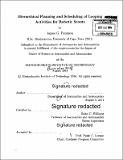Hierarchical planning and scheduling of looping a activities for robotic scouts
Author(s)
Paterson, James G. (James Gordon)
DownloadFull printable version (10.16Mb)
Other Contributors
Massachusetts Institute of Technology. Department of Aeronautics and Astronautics.
Advisor
Brian C. Williams.
Terms of use
Metadata
Show full item recordAbstract
A wide range of robotic missions contain activities that exhibit looping behaviour. Examples of these activities include picking fruit in agriculture, pick-and-place tasks in manufacturing, or even search patterns in robotic observing missions. These looping activities often have a range of acceptable loop values and a preference function over them. For example, during robotic survey missions, information gain is expected to increase with the number of loops in a search pattern. Since these looping activities also take time, which is typically bounded, there is a challenge of maximizing utility while respecting time constraints. While current scheduling techniques allow us to specify disjunctive temporal constraints and preference over time, they do not allow us to represent looping constraints, or preference over the number of loops. In this thesis, we provide a capability to optimally choose between multiple candidate plans by selecting threads of execution and the number of loops within each activity, while respecting temporal constraints. To achieve this, we first present a new scheduling problem; the looping temporal problem with preference (LTPP), as a formalism for encoding scheduling problems that contain looping activities, and provide an algorithm to solve it. The LTPP expresses temporal and looping constraints in a compact form, while adding a preference function on the number of loops between two temporal events. Second, we enable hierarchical temporal planning over looping activities through an optimal temporal planner that uses the LTPP scheduler at its core. This planner takes a looping temporal plan network (LTPN) as an input and produces a consistent, least-commitment temporal plan that optimizes the global value of all preference functions. This least-commitment plan can then be dispatched to the robot online allowing for robustness to temporal disturbances during execution. We demonstrate the capabilities of these algorithms on problems from the search-and-rescue domain.
Description
Thesis: S.M., Massachusetts Institute of Technology, Department of Aeronautics and Astronautics, 2014. Cataloged from PDF version of thesis. Includes bibliographical references (pages 89-91).
Date issued
2014Department
Massachusetts Institute of Technology. Department of Aeronautics and AstronauticsPublisher
Massachusetts Institute of Technology
Keywords
Aeronautics and Astronautics.